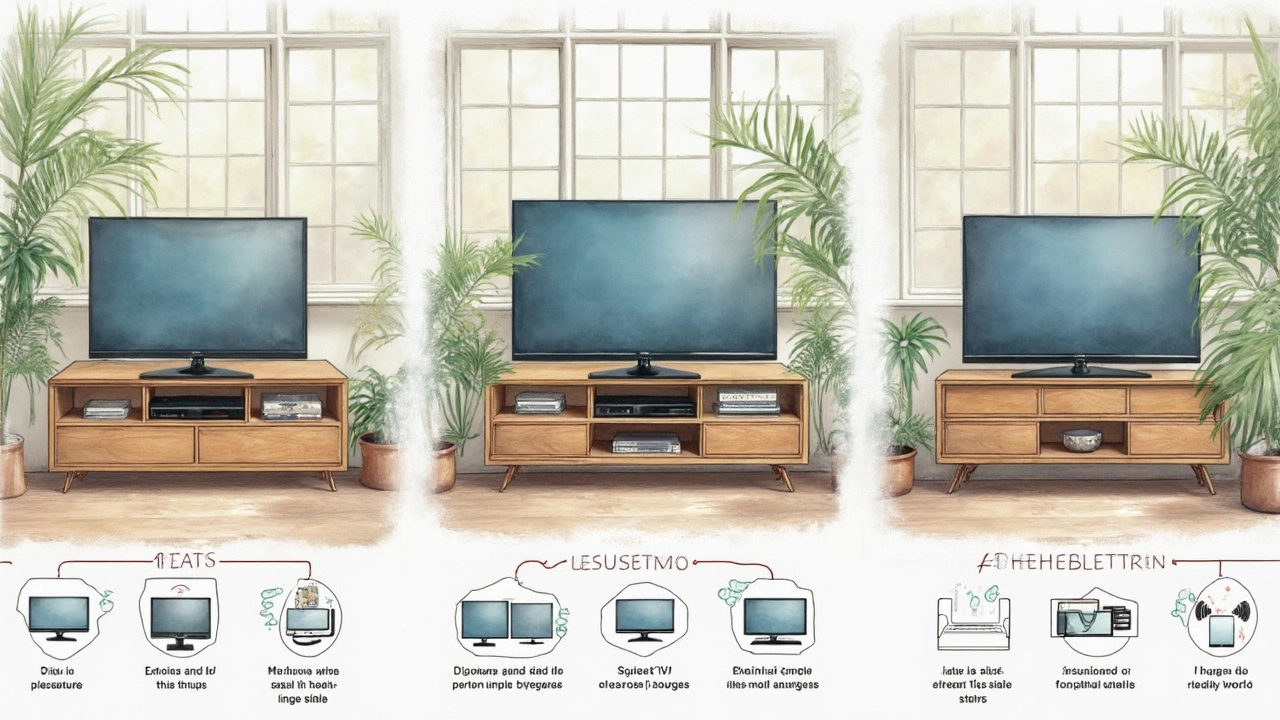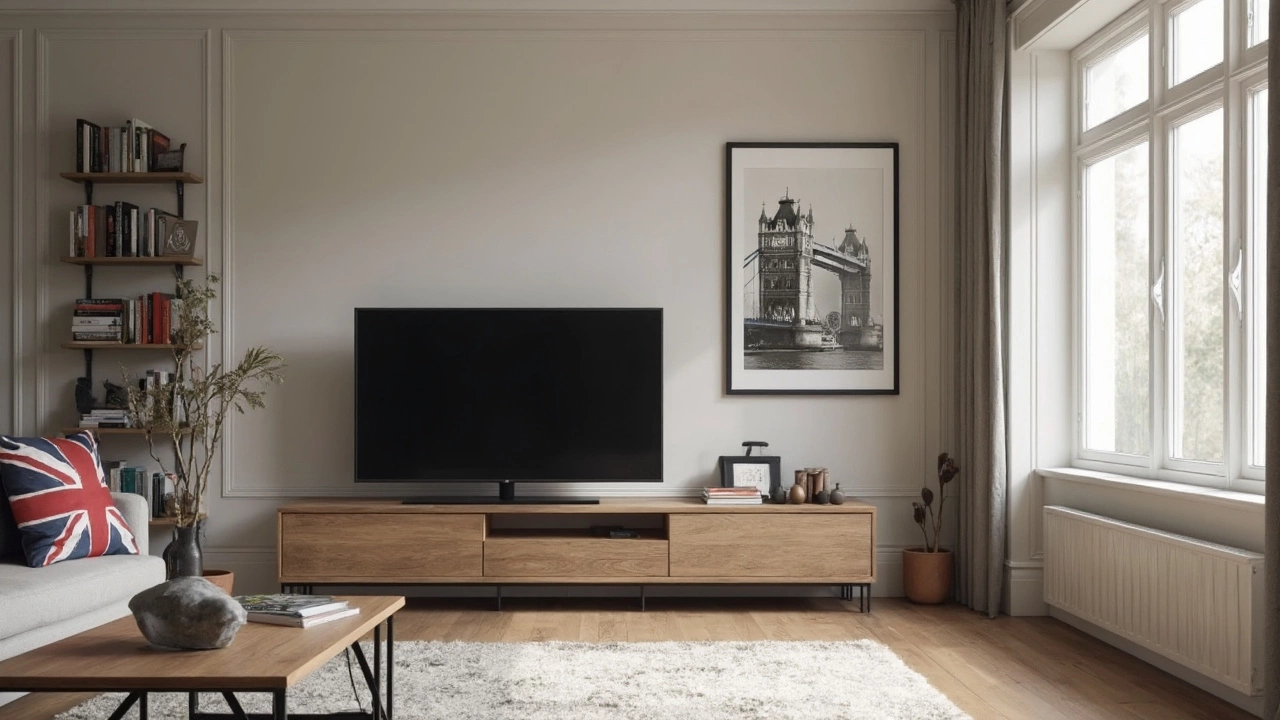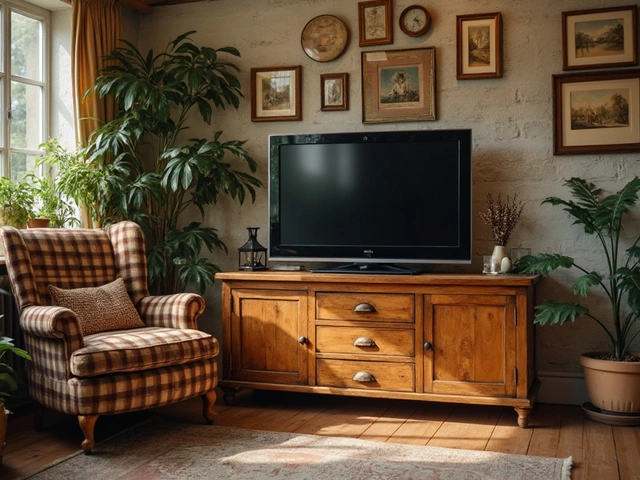Ever felt like your TV is either towering over you or barely peeking above the coffee table? Picking out a TV stand isn’t just about grabbing the first stylish piece you see online. There's an actual rule: your TV stand should be at least as wide as your TV—preferably a few inches wider on each side. Why? It keeps your TV from looking awkwardly balanced, and let’s be honest, it just feels safer if someone bumps into it.
Size isn’t the only thing people mess up. Height is a big deal, too. The goal is to have the middle of your screen at eye level while you’re sitting down. Here’s a tip: Measure the distance from the floor to your eyes when you’re on the couch. Then, make sure the center of your TV lines up with that height when it’s on the stand. Get these basics right, and suddenly movie night feels way more comfortable.
- Size Matters: Matching Stand to TV
- Getting the Height Right
- Safety and Stability Basics
- Smart Storage and Cable Tricks
Size Matters: Matching Stand to TV
First rule? Your TV stand has to match your TV's width—don’t try to squeeze a giant flat screen onto a tiny table. The golden rule is that your stand should be at least as wide as your TV, but going a few inches wider on each side actually makes things safer and looks way better. If your TV's not centered or balanced, it can tip easily, especially if you’ve got kids or pets running around.
TV manufacturers measure screens diagonally, but when you shop for a stand, you need the actual width, not the diagonal. Here's a quick tip: Grab a measuring tape and measure edge-to-edge. For example, a 55-inch TV (diagonal) usually has a width of around 48 inches. Your stand should be at least this wide—ideally more.
| TV Size (Diagonal) | Approx. TV Width (Inches) | Recommended Stand Width (Inches) |
|---|---|---|
| 43" | 38" | 40"+ |
| 55" | 48" | 50"+ |
| 65" | 57" | 60"+ |
But don’t just stop with width. Think about depth, too. Some older TVs or ones with chunky stands need more space at the back. Slim, modern TVs don’t, but make sure you double-check measurements so you’re not hanging off the edge.
And if you’re into home theater setups or soundbars, factor them in. There’s nothing worse than buying the perfect stand and realizing your soundbar blocks the TV’s remote sensor or covers the screen. Think about everything you want on that stand, not just the TV.
Getting the Height Right
Nailing the height of your TV stand is way more important than most folks think. If your TV is too high or too low, your neck will let you know within minutes. Here’s the rule: The center of your TV screen should line up with your eyes when you’re sitting on your main viewing spot—usually the couch.
For most people, this hits somewhere between 42 and 48 inches off the floor. Got a tape measure? Sit down, look straight ahead, and mark the spot where your eyes hit the wall. That’s where the middle of the screen should be. If you already bought the stand, don’t panic—just tweak your seating or try a tilt mount to help.
- Measure your seated eye level from the floor (most adults hit 40-42 inches).
- Find the height to the center of your TV screen (not the bottom or the top).
- Choose a stand so your screen’s center aligns with your eye level, adjusting as close as possible.
If your TV size is large (like 65 inches or up), double check that your stand can handle the added height and weight. TV stands are built with a range in mind, but not every piece is up for the job. Here’s a quick glance at common eye-level ranges for living rooms, paired with recommended stand heights:
| Eye Level | TV Size | Recommended Stand Height |
|---|---|---|
| 40-42" | 55-65" | 24-26" |
| 42-45" | 65-75" | 18-22" |
| 35-38" (short chairs) | 40-50" | 28-30" |
If you ever watched TV at your parents’ place and felt like squinting up at a cinema wall, you know it’s a pain. The right height turns binge-watching into a neck-friendly treat—no chiropractor needed.

Safety and Stability Basics
Ever seen a toddler pull at a TV stand? Not pretty. The first rule—especially if you’ve got pets or kids bouncing around—is to make sure your TV stand is rock solid. You don’t want to risk the TV wobbling or, worse, tipping over. Some stands come with safety straps or anti-tip kits that let you anchor things to the wall. If yours doesn’t, stop by a hardware store and pick up a universal version.
Let’s talk weight limits. Every stand should say how much it can hold. Don’t just check if it supports the size of your TV, but also its weight. Newer TVs are lighter than those from five years ago, but you still need to double-check. Here’s a quick reference for average TV weights by size:
| Screen Size | Avg. TV Weight (lbs) |
|---|---|
| 32" | 10-15 |
| 50" | 25-35 |
| 65" | 45-60 |
Don’t let your TV overhang the edge. If the stand is too small, it's basically an accident waiting to happen. Make sure the TV legs or base have plenty of room to rest flat, without the risk of sliding off.
Next, check the stand's own stability. Glass panels might look nice but can shatter if something topples onto them. If you want extra peace of mind, go for stands with solid wooden or metal frames. Also, make sure any shelves are securely attached and not just balanced or slotted in—the last thing you need is the shelf collapsing when you stack devices on it.
- Anchor the stand to the wall if it’s tall or top-heavy.
- Always follow the stand’s manual for assembly. Don’t skip screws or brackets just because they seem “optional.”
- Keep heavy items low. Store the heaviest stuff (like receivers or gaming consoles) at the bottom of the stand—this keeps the center of gravity low.
And if your floor is a bit uneven? Use leveling feet if your stand has them, or pop a furniture pad under one side. It’s a small step, but it keeps everything steady, especially on old hardwood floors or carpets.
Smart Storage and Cable Tricks
One thing people usually forget with a TV stand is storage. Streaming boxes, gaming consoles, remotes, and stacks of old DVDs can turn your media area into a mess if you don't plan ahead. Look for a stand with shelves or closed cabinets. If you have kids or pets, doors that close with a magnet can save you from endless hunting for lost remotes. Open shelving is good for devices that heat up or need a clear signal for remotes, but closed storage keeps things looking neat way easier.
Cable management is a game changer if you hate tangled wires. Most good TV stands today have built-in cutouts or channels at the back. These little holes let you run power cords and HDMI cables to your TV without making your living room look like a spider web exploded. If your stand doesn’t come with these, you can buy cheap adhesive clips or sleeves to wrangle your cables. Don’t just shove them behind the stand—this almost always leads to dust, accidental unplugging, and frustration next time you need to swap out a device.
For folks who want total order, here's a super simple cable trick: use colored zip ties or labels so you instantly know which cable does what. This is especially handy if you have a soundbar, gaming system, or a smart TV setup with multiple devices. When you need to move stuff around, you’ll thank yourself big time. Here’s a quick checklist to get your TV stand storage and cables sorted out:
- Pick a stand that fits all your devices, not just your TV.
- Use closed cabinets for things you want to hide.
- Choose open shelves for anything that needs better airflow.
- Feed cables through built-in cutouts or use stick-on cable clips.
- Label cables and group them so you never lose track.
According to a 2023 survey by CNET, nearly 60% of households say that visible cables and clutter are their biggest gripes in their living room. Simple steps like these don’t just improve looks—they save real time and hassle when you upgrade or fix your setup.



